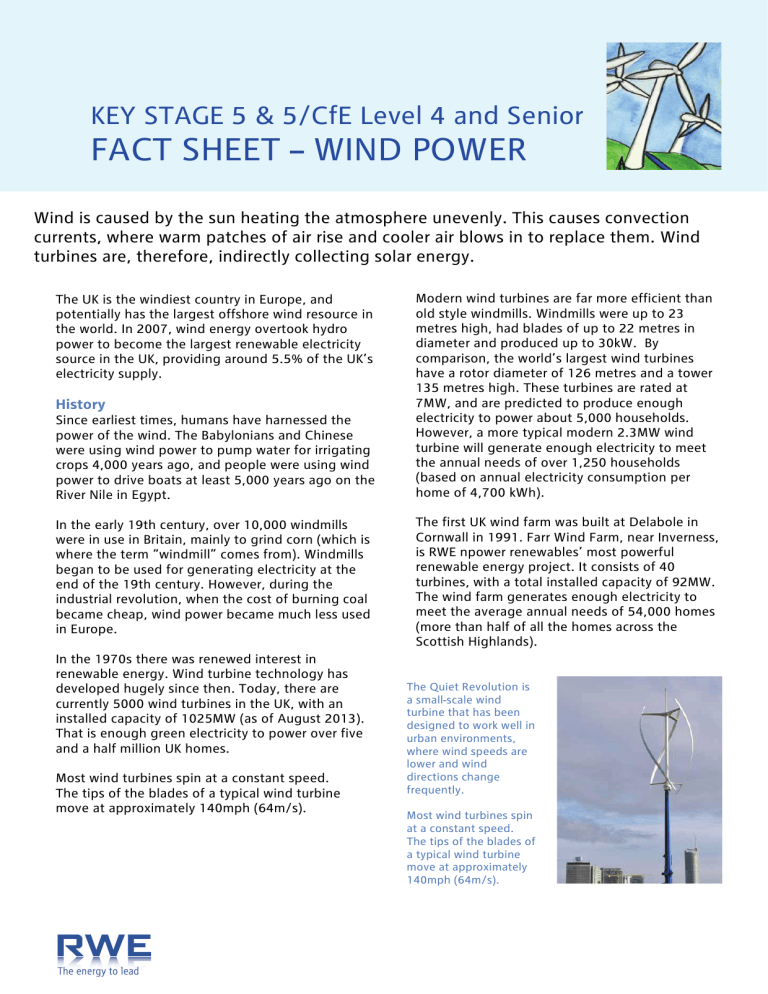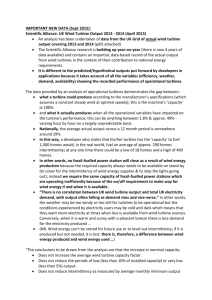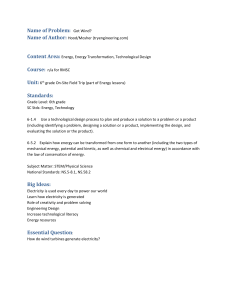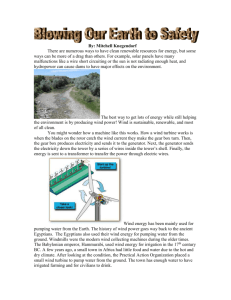FACT SHEET – WIND POWER
advertisement

KEY STAGE 5 & 5/CfE Level 4 and Senior FACT SHEET – WIND POWER Wind is caused by the sun heating the atmosphere unevenly. This causes convection currents, where warm patches of air rise and cooler air blows in to replace them. Wind turbines are, therefore, indirectly collecting solar energy. The UK is the windiest country in Europe, and potentially has the largest offshore wind resource in the world. In 2007, wind energy overtook hydro power to become the largest renewable electricity source in the UK, providing around 5.5% of the UK’s electricity supply. History Since earliest times, humans have harnessed the power of the wind. The Babylonians and Chinese were using wind power to pump water for irrigating crops 4,000 years ago, and people were using wind power to drive boats at least 5,000 years ago on the River Nile in Egypt. In the early 19th century, over 10,000 windmills were in use in Britain, mainly to grind corn (which is where the term “windmill” comes from). Windmills began to be used for generating electricity at the end of the 19th century. However, during the industrial revolution, when the cost of burning coal became cheap, wind power became much less used in Europe. In the 1970s there was renewed interest in renewable energy. Wind turbine technology has developed hugely since then. Today, there are currently 5000 wind turbines in the UK, with an installed capacity of 1025MW (as of August 2013). That is enough green electricity to power over five and a half million UK homes. Most wind turbines spin at a constant speed. The tips of the blades of a typical wind turbine move at approximately 140mph (64m/s). Modern wind turbines are far more efficient than old style windmills. Windmills were up to 23 metres high, had blades of up to 22 metres in diameter and produced up to 30kW. By comparison, the world’s largest wind turbines have a rotor diameter of 126 metres and a tower 135 metres high. These turbines are rated at 7MW, and are predicted to produce enough electricity to power about 5,000 households. However, a more typical modern 2.3MW wind turbine will generate enough electricity to meet the annual needs of over 1,250 households (based on annual electricity consumption per home of 4,700 kWh). The first UK wind farm was built at Delabole in Cornwall in 1991. Farr Wind Farm, near Inverness, is RWE npower renewables’ most powerful renewable energy project. It consists of 40 turbines, with a total installed capacity of 92MW. The wind farm generates enough electricity to meet the average annual needs of 54,000 homes (more than half of all the homes across the Scottish Highlands). The Quiet Revolution is a small-scale wind turbine that has been designed to work well in urban environments, where wind speeds are lower and wind directions change frequently. Most wind turbines spin at a constant speed. The tips of the blades of a typical wind turbine move at approximately 140mph (64m/s). WIND POWER CONT… Rhyl Flats is located approximately 8 kilometres off the coast of North Wales, and is currently the largest operating renewable energy scheme in Wales and one of the most powerful offshore wind farms in the UK (pictured). It comprises 25 wind turbines and provides enough clean, green electricity to satisfy the needs of approximately 61,000 homes every year. Rhyl Flats offshore wind farm A small difference in the wind speed makes a big difference to the power output of a wind turbine. (The power in the wind is proportional to wind speed cubed.) The wind speed increases the higher up you go, which is why wind turbines are so tall. The power output of the turbine is also related to the swept area of the turbine blades. The greater the area, the larger the amount of power the turbine can convert from the wind. Modern wind turbines produce electricity 70-85% of the time, but generate different outputs depending on wind speed. Over the course of a year, they will generate about 30% of the theoretical maximum output. This is known as its capacity factor. How wind turbines work The energy in the wind can be turned into electricity by using a turbine to drive an electrical generator. The wind turns the turbine blades, which turn a shaft inside the nacelle (the box at the top of the turbine). In the majority of wind turbines, the shaft goes into a gearbox, which increases the rotation speed enough for the generator, which then uses magnetic fields to convert the rotational energy into electricity. The electricity then goes into a transformer, which converts it into a higher voltage for distribution. Advantages Disadvantages Wind power does not cause climate change or pollution. The speed of the wind is affected by many different factors such as weather, time of day and landscape. This makes it an intermittent source of energy, which cannot be used to generate electricity on demand. Wind is a renewable resource – as long as the sun shines and the wind blows it will never run out. Wind energy is a cheap way to produce renewable energy. The land underneath wind turbines can still be used for farming. Wind turbines can be seen from long distances, and some people do not like the way they look.









